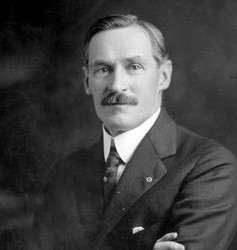Edward O. Sisson - 1917-1921
Edward O. Sisson
September 1917 - August 1921
"Richer than any fiscal abundance is the human wealth of the University."
Education
- B.S., Kansas State Agricultural College, 1886
- A.B., University of Chicago, 1893
- Ph.D., Harvard University, 1905
Accomplishments as President
Sisson's administration faced many hardships due to World War I. As men enlisted in the military, the numbers of male professors and students fell drastically. Many student activities ceased, including those of the fraternity and sorority events, as well as many academic training programs. After the War, student enrollment and involvement increased dramatically. The University celebrated its first Homecoming in 1919, with the first literary magazine published the following year. Sisson's administration adopted a new grading system and a set of eligibility rules for athletes, debaters and orators, publication managers, and leading theatre actors. Sisson's presidency also saw increased advantages for UM faculty, including tenure and a three-month mandatory warning for professors no longer needed by the University. In addition, Sisson appointed the first members of the Curricula for the College of Arts and Sciences and approved the formation of the Budget and Policy Committee.
Background History
Before serving as UM President, Edward O. Sisson held several important positions in the educational field. As one of the earliest advocates of the character-education movement, he wrote several books and articles related to education and philosophy. After receiving his Bachelor's Degree with honors from the University of Chicago, Sisson became the head of the Bradley Institute of Technology. He left this position in 1901 to obtain his Ph.D. He then served as the head of the Department of Education at the University of Washington before joining the faculty at Reed College. In 1911, he became the first Commissioner of Education in Idaho.
Following the Presidency
After taking a leave of absence due to illness in 1920, Sisson left the presidency in August 1921. He returned to Reed College as a professor of philosophy and continued to publish works in the field of education. Although he retired from teaching in 1931, Sisson proceeded to give public lectures on philosophy and education until his death in 1949.

Landmarks Erected
- Memorial Row, 1919
- Simpkins Hall, 1920 (razed in 1960)
- Marcus Cook Hall, 1921 (razed in 1935)
Programs Established
- School of Business Administration
- Departments of Astronomy and Military Science
- Pre-Medicine Program
- Student Army Training Corps
